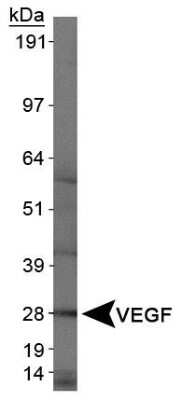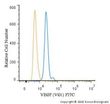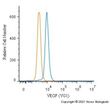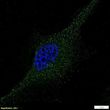VEGFA Mouse Monoclonal Antibody [Clone ID: VG1]
Frequently bought together (2)
Transient overexpression lysate of vascular endothelial growth factor A (VEGFA), transcript variant 7
USD 436.00
Other products for "VEGFA"
Specifications
| Product Data | |
| Clone Name | VG1 |
| Applications | IHC, WB |
| Recommended Dilution | Flow Cytometry, Western Blot: 1-2 ug/ml, Immunocytochemistry/ Immunofluorescence: 1:10-1:500, Immunohistochemistry: 1:20-1:100, Immunohistochemistry-Frozen: 1:20-1:100, Immunohistochemistry-Paraffin: 1:20-1:100, CyTOF-ready, ELISA, Simple Western |
| Reactivities | Human, Mouse, Rat, Canine |
| Host | Mouse |
| Isotype | IgG1, kappa |
| Clonality | Monoclonal |
| Immunogen | Recombinant VEGF 189 protein. |
| Formulation | PBS containing 0.05% BSA, 0.05% Sodium Azide. Store at 4C short term. Aliquot and store at -20C long term. Avoid freeze-thaw cycles. |
| Concentration | lot specific |
| Purification | Protein G purified |
| Conjugation | Unconjugated |
| Storage | Store at -20°C as received. |
| Stability | Stable for 12 months from date of receipt. |
| Gene Name | vascular endothelial growth factor A |
| Database Link | |
| Background | VEGF (vascular endothelial growth factor) is a homodimeric, disulfide-linked glycoprotein growth factor that plays a critical role in angiogenesis, vasculogenesis and endothelial cell growth through induction of endothelial cell proliferation and blood vessels permeabilization, cell migration promotion as well as inhibition of apoptosis. VEGF can bind to FLT1/VEGFR1 and KDR/VEGFR2 receptors, heparan sulfate and heparin. Its isoforms VEGF189, VEGF165 and VEGF121 are widely expressed, whereas, other isoforms VEGF206 and VEGF145 are not very common. The basic isoform VEGF189 is cell-associated after secretion and is bound avidly by heparin and the extracellular matrix, although it may be released as a soluble form by heparin, heparinase or plasmin. VEGF bind to three tyrosine-kinase receptors, VEGFR-1, VEGFR-2 and VEGFR-3 which are expressed almost exclusively in endothelial cells. VEGFR-2 is the main angiogenic signal transducer for VEGF, while VEGFR-3 is specific for VEGF-C/-D (may gain VEGFR-2 binding ability via proteolytic processing) and is essential for lymphangiogenic signaling. VEGF is regulated by growth factors, cytokines, gonadotropins, nitric oxide, hypoxia, hypoglycemia and oncogenic mutations. Defects in VEGFA are linked to MVCD1 (microvascular complications of diabetes type 1) and VEGF polymorphisms are associated with susceptibility to multiple cancers, e.g., glioma, HCC, ovarian, bladder, prostate, breast cancer etc. |
| Synonyms | MVCD1; VEGF; VPF |
| Note | This VEGF antibody is useful for Immunohistochemistry (frozen and paraffin-embedded sections), Western blot and Immunocytochemistry/Immunofluorescence. ELISA was reported in scientific literature. In IHC a dilution of 1:20-1:50 was used in an ABC method. However, depending on the staining conditions employed, we suggest that the final dilution should be determined by the user. We suggest an incubation period of 30-60 minutes at room temperature. High temperature treatment of formalin-fixed tissue sections using 1mM EDTA, pH 8.0 must be performed prior to the immunostaining. |
| Reference Data | |
| Protein Families | Druggable Genome, Secreted Protein |
| Protein Pathways | Bladder cancer, Cytokine-cytokine receptor interaction, Focal adhesion, mTOR signaling pathway, Pancreatic cancer, Pathways in cancer, Renal cell carcinoma, VEGF signaling pathway |
Documents
| Product Manuals |
| FAQs |
| SDS |
{0} Product Review(s)
0 Product Review(s)
Submit review
Be the first one to submit a review
Product Citations
*Delivery time may vary from web posted schedule. Occasional delays may occur due to unforeseen
complexities in the preparation of your product. International customers may expect an additional 1-2 weeks
in shipping.






























































































































































































































































 Germany
Germany
 Japan
Japan
 United Kingdom
United Kingdom
 China
China









